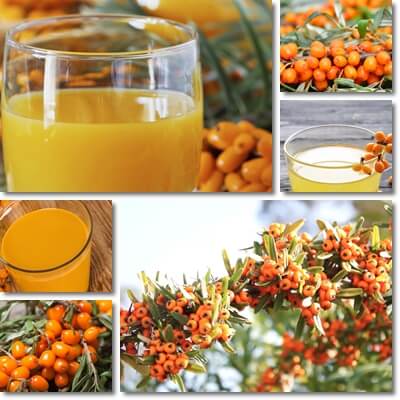Fruit juices are quite a popular food choice, more popular even than the fruits they’re made from. While it’s always better to choose whole fruits over fruit juices, when it comes to fruits such as sea-buckthorn, it’s understandable why people would choose the juice over the extremely astringent fruit. But in this case, drinking sea-buckthorn juice is not such a bad idea since you’re getting an even greater amount of essential micro-nutrients than from the berries themselves, including vitamin C, but also potassium and manganese, not to mention a wide range of antioxidants, most notably carotenoids such as beta-carotene and zeaxanthin. And with such a great nutrition value come a host of health benefits.
What is sea-buckthorn juice?
Sea-buckthorn juice is the juice extracted from sea-buckthorn berries. It is a bright-colored juice of a vivid yellow color, astringent and sour, just like the berries themselves. It is rarely available commercially since its tartness is not appealing to consumers.
Nevertheless, it is a particularly healthy juice, rich in antioxidants, vitamins and minerals that contribute to good nutrition and provide a range of benefits for health. Sea-buckthorn juice can be made at home and is best consumed fresh to get the most of its nutrition and benefits.

What does sea-buckthorn juice look like?
Sea-buckthorn juice made from yellow sea-buckthorn berries is a bright-colored juice of a vivid yellow color, overall quite similar-looking to orange juice. Sea-buckthorn juice made from orange berries is also vividly-colored, but bright orange. If made in a home setting, sea-buckthorn juice is opaque and thick, sometimes also with a thick layer of foam on top.
If the berries used are not perfectly ripe and the processing is not very efficient, the juice obtained will be thinner and maybe even slightly clear. The same is true if it’s diluted with water to lessen its astringency and sourness.
What does sea-buckthorn juice taste like?
Sea-buckthorn juice is highly acidic, astringent and sour-tasting, a result of the berries’ high content of organic acids. Its acidity and tartness can render it quite unpalatable, but it can be sweetened and diluted to improve taste and encourage consumption. Sea-buckthorn juice from commercial sources is likely diluted and sweetened, unless otherwise labeled.
Some of the factors that impact the way sea-buckthorn juice looks and tastes include the choice of production method (industrially-produced for commercial use vs home-made using household methods and appliances), the species and subspecies of sea-buckthorn the juice is made from, berry ripeness (the riper the berries, the higher the juice yield and the higher the carotenoid content and the better-looking the juice color) and more.

Sea-buckthorn juice properties
- High antioxidant content, highest in vitamin C (ascorbic acid), carotenoids (both carotenes and xanthophylls such as beta-carotene, zeaxanthin, lycopene) and flavonols (isorhamnetin, quercetin etc.)
- High vitamin C content. Depending on species, ripening stage, geographical region and other factors that impact plant nutrition, sea-buckthorn berries are estimated to contain an average of almost 700 mg of vitamin C/100 g of raw berries and up to 1550 mg and even 2500 mg of vitamin C in some subspecies from certain regions. If processed fresh and consumed shortly after, sea-buckthorn juice can be even higher in vitamin C than the fresh berries.
- High acidity. The berries are extremely astringent and taste simply too tart to eat, and so does the juice made from them. However, you can always sweeten and even dilute the juice to make it as palatable as you would like.
- High mineral content. Both sea-buckthorn berries and the juice made from them are high in essential minerals such as copper, chromium, iron, manganese, molybdenum and potassium. The juice is even higher in potassium and manganese than the berries, but tends to be lower in chromium, copper, molybdenum and iron.
- Low-sugar. Sea-buckthorn juice is fairly low-sugar which contributes to its beneficial properties.
- Source of fat and fat-soluble vitamins. You can extract oil from both sea-buckthorn seeds and fruit pulp. Sea-buckthorn juice is a source of both healthy fatty acids and fat-soluble vitamins such as vitamins A, E and K1. Also see the properties and benefits of sea-buckthorn tea.
What are the benefits of Sea-Buckthorn Juice?
- Combats dehydration and associated fatigue. Diluted sea-buckthorn juice is a great way to increase your fluid intake the nutritious way and combat dehydration symptoms such as fatigue.
- Anti-inflammatory properties. High in vitamin C even when diluted with water, sea-buckthorn juice is a great general anti-inflammatory with benefits for the entire system.
- Immune-boosting benefits. The high vitamin C content of sea-buckthorn juice optimizes the immune system response to infection and disease by enhancing the activity of white blood cells such as NK cells, B cells, T cells, neutrophils and macrophages for a boost in immunity.
- Promotes wound healing. The wound healing properties of sea-buckthorn juice are primarily a result of its extremely high vitamin C content. Vitamin C exerts an antimicrobial action that prevents infection, anti-inflammatory effects that hurry wound healing and sustains collagen synthesis for the renewal of damaged tissue. See what vitamin C does for wound healing.
- Antiviral properties. High in vitamin C, sea-buckthorn juice builds up immune system defenses and exerts an antiviral action against influenza viruses, potentially contributing to lower rates of infection, more tolerable symptoms and possibly also a shorter infection duration.
- Tonic and restorative properties. Sea-buckthorn juice is an important source of essential nutrients such as vitamin C and pro-vitamin A carotenes, but also B vitamins and minerals such as calcium, chromium, copper, manganese, molybdenum, magnesium, potassium and more, and thus exerts a tonic, restorative action on the whole body.
- Anti-aging benefits. A high intake of vitamin C can delay aging signs such as loose skin and wrinkles. Vitamin C promotes the synthesis of collagen, a protein that gives structure and elasticity to skin. Collagen synthesis decreases naturally over time which is why increasing vitamin C intake can up production for a more youthful appearance.
- Other benefits for skin. Owing to its high content of pro-vitamin A antioxidants (mainly carotenes such as beta-carotene), sea-buckthorn juice supports reparative processes of the skin.
- Good for eyesight. As a result of its pro-vitamin A antioxidant content, the juice promotes the physical health of the eyes and holds benefits for visual acuity, color vision and low-light (aka night) vision. As an added benefit, home-made sea-buckthorn juice further contains fat from the pulp which optimizes the absorption of pro-vitamin A antioxidants and their subsequent conversion into vitamin A. Other antioxidants such as zeaxanthin and lutein further promote the physical health of the eyes.
- Good for high blood pressure. Studies show sea-buckthorn juice to be an important source of potassium, better even than the fresh berries. Potassium is best known for its strong anti-hypertensive benefits and is the number one nutrient to target for supplementation if you want to lower your blood pressure numbers.
- Antioxidant benefits. The vividly-colored juice is rich in antioxidants, from vitamin C (ascorbic acid) to flavonols and other polyphenols (e.g. alpha-tocopherol or vitamin E, beta-carotene, lutein, zeaxanthin, taraxanthin, beta-cryptoxanthin, lycopene, quercetin, catechins, isorhamnetin etc.). The antioxidants exert strong free radical-scavenging effects which help prevent and repair cell damage.
- Hepato-protective properties. As a result of its high antioxidant content, the most notable of which is vitamin C, sea-buckthorn juice has a protective effect on the liver, actively supporting liver health.
Note: The quality of the juice will determine its therapeutic effects. More likely than not, sea-buckthorn juice will be diluted and sweetened to render it not just palatable, but edible really, given its high astringency and extreme tartness. This will automatically mean its nutrition will vary depending on how diluted it is, and on how processed (commercial production of the juice lowers its chromium and molybdenum content by half and up to 3/4 and its copper and iron content by around half).
What are the side effects of Sea-Buckthorn Juice?
- Causes heartburn. Drinking sea-buckthorn juice can cause heartburn, a burning sensation in the chest. The side effect is a direct result of the high content of organic acids in the juice which make it taste tart and astringent. The side effects are more pregnant if the juice is undiluted or consumed in large amounts.
- Triggers acid reflux. Whether you have GERD or not, sea-buckthorn juice tends to cause acid reflux which is the regurgitation of stomach juice and other stomach contents. The side effect is caused by the juice having a high acidity. The effects are directly proportional with intake.
- Digestive upset. Drinking sea-buckthorn juice can result in digestive upset for some people due to the juice’s acidity. The digestive upset can take the form of a sour stomach, stomach pain such as belly-button pain, but also cramps, lack of appetite, heartburn or nausea.
- Dry mouth and lips. The juice being extremely astringent, it can result in dry mouth and lips, especially if undiluted.
- Bad for gastritis and peptic ulcers. If you have gastritis or a stomach ulcer, acidic foods such as sea-buckthorn juice are not good for you as they will cause flare ups in the conditions and trigger and worsen symptoms.
How to make sea-buckthorn juice at home
- Remove the stems off your berries, clean with water and tap dry with a paper towel.
- Use available kitchen appliances to extract the juice: e.g. juicer or food processor, blender or hand blender. If using a food processor or blender, you will get a mushy pulp which you then have to strain using a clean cheese cloth or fine sieve in order to separate the juice from the pulp.
- Dilute and sweeten the juice according to taste and consume soon after extraction to minimize nutrient loss and get the most of its benefits.
Note: You can refrigerate (or even freeze) any remaining juice for use at a later time. For example, sea-buckthorn juice is a great substitute for lemon and other citrus juices and can be used in baked goods or marinades or any dish that requires a bit of sharpness.
Tip: Leftover juice should be stored in the refrigerator as quickly as possible. To best preserve its nutritional value and properties, store in a dark container, ideally from glass, and make sure that it’s sealed to prevent air from oxidizing elements in the juice.
The juice can be made from any species and subspecies of sea-buckthorn, both from yellow and orange-colored varieties, sourced from the wild or from cultivated plants. In order to get the best juice yield and the healthiest and best-looking juice, the sea-buckthorn berries should be at their ripest, picked before the first frosts, and processed as soon as possible following harvesting. Similarly, the juice should be consumed quickly so as to reduce oxidation that could affect its nutritional value and therapeutic properties.
